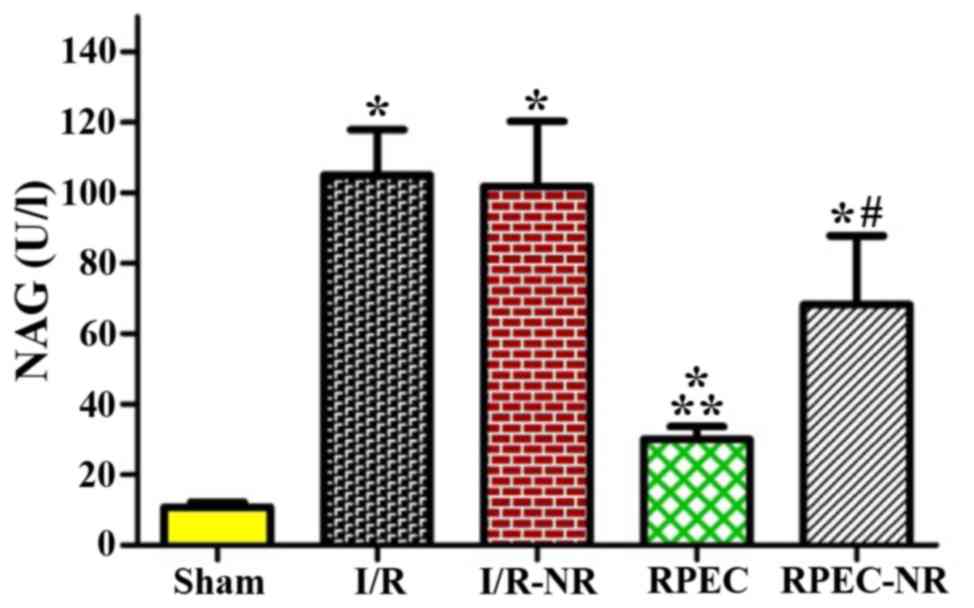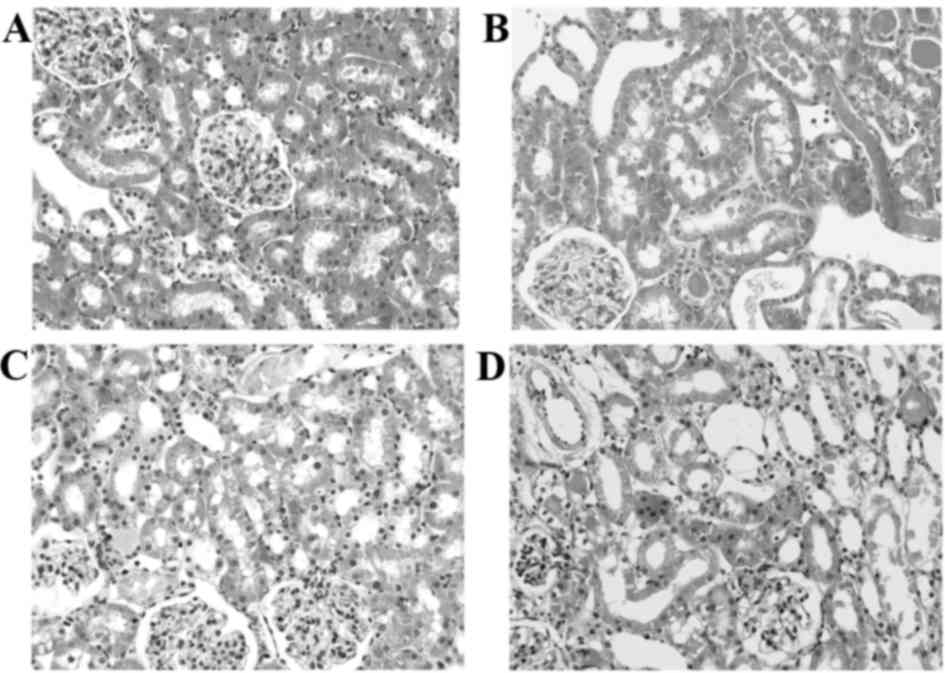|
1
|
Cooper JE and Wiseman AC: Acute kidney
injury in kidney transplantation. Curr Opin Nephrol Hypertens.
22:698–703. 2013. View Article : Google Scholar : PubMed/NCBI
|
|
2
|
Glodowski SD and Wagener G: New insights
into the mechanisms of acute kidney injury in the intensive care
unit. J Clin Anesth. 27:175–180. 2014. View Article : Google Scholar : PubMed/NCBI
|
|
3
|
Hausenloy DJ and Yellon DM: Ischaemic
conditioning and reperfusion injury. Nat Rev Cardiol. 13:193–209.
2016. View Article : Google Scholar : PubMed/NCBI
|
|
4
|
Hu J, Liu S, Jia P, Xu X, Song N, Zhang T,
Chen R and Ding X: Protection of remote ischemic preconditioning
against acute kidney injury: A systematic review and meta-analysis.
Crit Care. 20:1112016. View Article : Google Scholar : PubMed/NCBI
|
|
5
|
McCafferty K, Byrne C and Yaqoob MM:
Ischaemic conditioning strategies for the nephrologist: A promise
lost in translation? Nephrol Dial Transplant. 29:1827–1840. 2014.
View Article : Google Scholar : PubMed/NCBI
|
|
6
|
Sedaghat Z, Kadkhodaee M, Seifi B, Salehi
E, Najafi A and Dargahi L: Remote perconditioning reduces oxidative
stress, downregulates cyclo-oxygenase-2 expression and attenuates
ischaemia-reperfusion-induced acute kidney injury. Clin Exp
Pharmacol Physiol. 40:97–103. 2013. View Article : Google Scholar : PubMed/NCBI
|
|
7
|
Liem DA, Verdouw PD, Ploeg H, Kazim S and
Duncker DJ: Sites of action of adenosine in interorgan
preconditioning of the heart. Am J Physiol Heart Circ Physiol.
283:H29–H37. 2002. View Article : Google Scholar : PubMed/NCBI
|
|
8
|
Schoemaker RG and van Heijningen CL:
Bradykinin mediates cardiac preconditioning at a distance. Am J
Physiol Heart Circ Physiol. 278:H1571–H1576. 2000.PubMed/NCBI
|
|
9
|
Wolfrum S, Nienstedt J, Heidbreder M,
Schneider K, Dominiak P and Dendorfer A: Calcitonin gene related
peptide mediates cardioprotection by remote preconditioning. Regul
Pept. 127:217–224. 2005. View Article : Google Scholar : PubMed/NCBI
|
|
10
|
Lim SY, Yellon DM and Hausenloy DJ: The
neural and humoral pathways in remote limb ischemic
preconditioning. Basic Res Cardiol. 105:651–655. 2010. View Article : Google Scholar : PubMed/NCBI
|
|
11
|
Czigány Z, Turóczi Z, Kleiner D, Lotz G,
Homeyer A, Harsányi L and Szijártó A: Neural elements behind the
hepatoprotection of remote perconditioning. J Surg Res.
193:642–651. 2015. View Article : Google Scholar : PubMed/NCBI
|
|
12
|
Kadkhodaee M, Seifi B, Najafi A and
Sedaghat Z: First report of the protective effects of remote per-
and postconditioning on ischemia/reperfusion-induced renal injury.
Transplantation. 92:e552011. View Article : Google Scholar : PubMed/NCBI
|
|
13
|
Horak E, Hopfer SM and Sunderman FW Jr:
Spectrophotometric assay for urinary
N-acetyl-beta-D-glucosaminidase activity. Clin Chem. 27:1180–1185.
1981.PubMed/NCBI
|
|
14
|
Zaman J, Jeddi S and Ghasemi A: The
effects of ischemic postconditioning on myocardial function and
nitric oxide metabolites following ischemia-reperfusion in
hyperthyroid rats. Korean J Physiol Pharmacol. 18:481–487. 2014.
View Article : Google Scholar : PubMed/NCBI
|
|
15
|
Chai Q, Liu J and Hu Y: Cardioprotective
effect of remote preconditioning of trauma and remote ischemia
preconditioning in a rat model of myocardial ischemia/reperfusion
injury. Exp Ther Med. 9:1745–1750. 2015.PubMed/NCBI
|
|
16
|
Zuk A and Bonventre JV: Acute kidney
injury. Annu Rev Med. 67:293–307. 2016. View Article : Google Scholar : PubMed/NCBI
|
|
17
|
Schmid M, Dalela D, Tahbaz R, Langetepe J,
Randazzo M, Dahlem R, Fisch M, Trinh QD and Chun FK: Novel
biomarkers of acute kidney injury: Evaluation and evidence in
urologic surgery. World J Nephrol. 4:160–168. 2015. View Article : Google Scholar : PubMed/NCBI
|
|
18
|
Lu Y, Hu J and Dong C: Morphine may
enhance the cardioprotection induced by remote ischemic
perconditioning. Int J Cardiol. 187:443–444. 2015. View Article : Google Scholar : PubMed/NCBI
|
|
19
|
Yun J, Li J and Zuo Z: Transferred
inter-cell ischemic preconditioning-induced neuroprotection may be
mediated by adenosine A1 receptors. Brain Res Bull. 103:66–71.
2014. View Article : Google Scholar : PubMed/NCBI
|
|
20
|
Rassaf T, Totzeck M, Hendgen-Cotta UB,
Shiva S, Heusch G and Kelm M: Circulating nitrite contributes to
cardioprotection by remote ischemic preconditioning. Circ Res.
114:1601–1610. 2014. View Article : Google Scholar : PubMed/NCBI
|
|
21
|
Shimizu M, Saxena P, Konstantinov IE,
Cherepanov V, Cheung MM, Wearden P, Zhangdong H, Schmidt M, Downey
GP and Redington AN: Remote ischemic preconditioning decreases
adhesion and selectively modifies functional responses of human
neutrophils. J Surg Res. 158:155–161. 2010. View Article : Google Scholar : PubMed/NCBI
|
|
22
|
Skyschally A, Gent S, Amanakis G, Schulte
C, Kleinbongard P and Heusch G: Across-Species transfer of
protection by remote ischemic preconditioning with species-specific
myocardial signal transduction by reperfusion injury salvage kinase
and survival activating factor enhancement pathways. Circ Res.
117:279–288. 2015. View Article : Google Scholar : PubMed/NCBI
|
|
23
|
Turrell HE, Thaitirarot C, Crumbie H and
Rodrigo G: Remote ischemic preconditioning of cardiomyocytes
inhibits the mitochondrial permeability transition pore
independently of reduced calcium-loading or sarcKATP channel
activation. Physiol Rep. 2:e122312014. View Article : Google Scholar : PubMed/NCBI
|
|
24
|
Sedaghat Z, Kadkhodaee M, Seifi B and
Salehi E: Hind limb perconditioning renoprotection by modulation of
inflammatory cytokines after renal ischemia/reperfusion. Ren Fail.
38:655–662. 2016. View Article : Google Scholar : PubMed/NCBI
|
|
25
|
Sedaghat Z, Kadkhodaee M, Seifi B and
Ahghari P: Hepatoprotective effects of remote perconditioning
during renal ischemia. Bratisl Lek Listy. 115:675–679.
2014.PubMed/NCBI
|
|
26
|
Loukogeorgakis SP, Panagiotidou AT,
Broadhead MW, Donald A, Deanfield JE and MacAllister RJ: Remote
ischemic preconditioning provides early and late protection against
endothelial ischemia-reperfusion injury in humans: Role of the
autonomic nervous system. J Am Coll Cardiol. 46:450–456. 2005.
View Article : Google Scholar : PubMed/NCBI
|
|
27
|
Liem DA, Verdouw PD, Ploeg H, Kazim S and
Duncker DJ: Sites of action of adenosine in interorgan
preconditioning of the heart. Am J Physiol Heart Circ Physiol.
283:29–37. 2002. View Article : Google Scholar
|

















